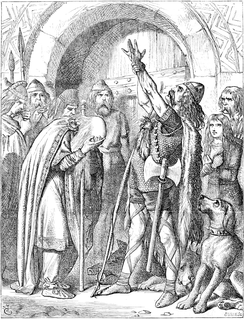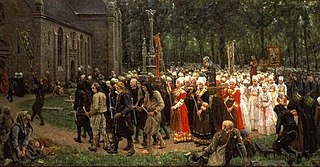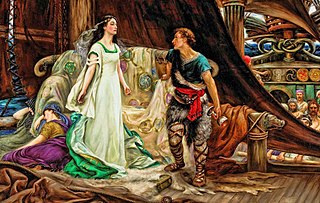 W
WBreton mythology is the mythology or corpus of explanatory and heroic tales originating in Brittany. The Bretons are the descendants of insular Britons who settled in Brittany from at least the third century. While the Britons were already Christianised in this era, the migrant population maintained an ancient Celtic mythos, similar to those of Wales and Cornwall.
 W
WAnkou is a servant of death in Breton, Cornish, Welsh and Norman French folklore.
 W
WBarzaz Breiz is a collection of Breton popular songs collected by Théodore Hersart de la Villemarqué and published in 1839. It was compiled from oral tradition and preserves traditional folk tales, legends and music. Hersart de la Villemarqué grew up in the manor of Plessix in Nizon, near Pont-Aven, and was half Breton himself.
 W
WDahut, also called Ahes, was a magician and a princess of Cornouaille (Brittany) present in several Breton legends.
 W
WLe Foyer breton is a collection of Breton stories by Émile Souvestre, written in French and published in 1844. This work is a collection of Breton folktales arranged by their place of origin. It was an immediate success, becoming the foremost work of prose narrative in Brittany, and inspiring several of the writer Ernest du Laurens de la Barre's works. It has been republished several times.
 W
WGoursez Vreizh is the national gorsedd of Brittany. It often has delegates from the Welsh gorsedd and Gorsedh Kernow in Cornwall. The Breton organisation is itself based on the Welsh-based Gorsedd, which was founded by Iolo Morganwg in 1792.
 W
WGradlon the Great was a semi-legendary 5th century "king" of Cornouaille who became the hero of many Breton folk stories. The most famous of these legends is the story of the sunken city of Ys. He is supposed to have been the son of Conan Meriadoc.
 W
WKing Hoel, also known as Sir Howel and Saint Hywel, was a late 5th- and early 6th-century member of the ruling dynasty of Cornouaille. He may have ruled Cornouaille jointly after the restoration of his father, Budic II of Brittany, but he seems to have predeceased his father and left his young son, Tewdwr, as Budic's heir.
 W
WIseult, alternatively Isolde, is the name of several characters in the legend of Tristan and Iseult. The most prominent is Iseult of Ireland, the wife of Mark of Cornwall and the lover of Tristan. Her mother, the queen of Ireland, is also named Iseult. The third is Iseult of the White Hands, the daughter of Hoel of Brittany and the sister of Kahedin.
 W
WThe Matter of Britain is the body of medieval literature and legendary material associated with Great Britain and Brittany, and the legendary kings and heroes associated with it, particularly King Arthur. It was one of the three great Western story cycles recalled repeatedly in medieval literature, together with the Matter of France, which concerned the legends of Charlemagne, and the Matter of Rome, which included material derived from or inspired by classical mythology.
 W
WLa Noce de Pierres Breton: An Eured Ven is an alignment of some 77 standing stones at the foot of Menez Michael (Saint-Michel-de-Brasparts) in the hills of Brittany. Aetiological folk tales say that the stones were originally the members of a drunken wedding party, petrified for their mistreatment of a stranger.
 W
WA pardon is a typically Breton form of pilgrimage and one of the most traditional demonstrations of popular Catholicism in Brittany. Of very ancient origin, probably dating back to the conversion of the country by the Celtic monks, it is comparable to the pattern days of pre-famine Ireland.
 W
W"Ar rannoù", also known as "Gousperoù ar raned", is a traditional Breton folksong, composed in twelve parts or "series".
 W
WTristan and Iseult is a chivalric romance retold in numerous variations since the 12th century, with a lasting impact on Western culture. The story is a tragedy about the adulterous love between the Cornish knight Tristan (Tristram) and the Irish princess Iseult. It tells of Tristan’s mission to escort Iseult from Ireland for marriage to his uncle, King Mark of Cornwall. On the journey home, the two of them ingest a love potion which brings about the adulterous relationship.
 W
WThe Vénus de Quinipily is an ancient statue of uncertain origins, located southeast of Baud, Morbihan, Brittany, in north–western France. It is approximately 2.2 metres (7.2 ft) in height and carved from granite. The statue represents a naked woman and stands in front of a fountain on a 2.75 m high granite pedestal. The large basin beneath the statue is also carved out of a single granite block. It is believed that the statue may be of Greek, Roman or Egyptian origin. There is similar uncertainty about its subject; it may be a Celtic deity, the Roman Mother goddess Cybele, or an Egyptian Isis statue.
 W
WYs, also spelled Is or Kêr-Is in Breton, and Ville d'Ys in French, is a mythical city on the coast of Brittany but later swallowed by the ocean. Most versions of the legend place the city in the Baie de Douarnenez.